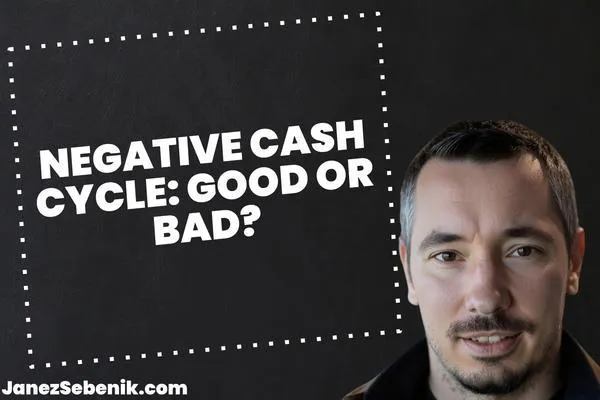
Is a negative cash conversion cycle good or bad?
A negative cash conversion cycle sounds bad, right? Wrong. It's actually a good thing for businesses.
A negative cash conversion cycle means a company gets paid by customers before it has to pay its suppliers. This is like getting an interest-free loan to run your business.
Think of it as a superpower for your company's cash flow. You're using other people's money to grow your business. Pretty sweet deal, huh?
Key Takeaways
A negative cash conversion cycle improves a company's cash flow and financial health
It allows businesses to use supplier funds to finance operations and growth
Achieving a negative cycle requires efficient inventory management and favorable payment terms
What Is the Cash Conversion Cycle?
The cash conversion cycle (CCC) is all about how quickly you turn your stuff into cold, hard cash. It's a simple yet powerful tool to measure your business efficiency.
Understanding the Basics
You've got inventory. You want to sell it. But how long does that take? That's where the CCC comes in. It measures the time between when you pay for your inventory and when you get paid for selling it.
Think of it like a race. The faster you complete the cycle, the better. A short CCC means you're running a tight ship. You're selling quickly and getting paid promptly.
But it's not just about speed. It's about balance. You want to hold inventory for the right amount of time, not too long or too short.
Cash Conversion Cycle Formula
Ready for some math? Don't worry, it's not rocket science. Here's the formula:
CCC = DIO + DSO - DPO
Let's break it down:
DIO: Days Inventory Outstanding (how long you hold inventory)
DSO: Days Sales Outstanding (how long customers take to pay you)
DPO: Days Payable Outstanding (how long you take to pay suppliers)
The goal? Make DIO and DSO as low as possible, and DPO as high as possible. This gives you a lower CCC, which means better cash flow for your business.
Remember, a negative CCC is possible and can be a good thing. It means you're getting paid before you even have to pay your suppliers. That's like having your cake and eating it too!
Diving into a Negative Cash Conversion Cycle
A negative cash conversion cycle is like having a money-printing machine. You get paid before you have to shell out cash. It's a sweet spot that can supercharge your business growth.
Explaining Negative CCC
You know how most businesses pay for stuff before they sell it? Well, not with a negative CCC. Here's the deal:
You sell your products before you pay your suppliers. It's like magic, but it's real.
Think of it as getting an interest-free loan from your customers. They pay you, and you use that cash to run your business.
Your inventory flies off the shelves faster than you can say "cha-ching". And your customers? They pay up quick.
Meanwhile, you've worked out killer deals with your suppliers. They're cool with you paying later.
Real World Examples
Ever heard of Amazon? Of course you have. They're the kings of negative CCC.
Amazon gets paid by customers right away. But they don't pay their suppliers for weeks.
That gap? It's pure gold. They use that cash to grow their empire.
eBay's another winner in this game. They don't even hold inventory. Talk about efficiency!
These giants turn their cash cycle into a growth engine. They use your money to make more money.
You don't have to be a tech giant to pull this off. Focus on quick sales, speedy payments, and supplier negotiations.
A negative cash conversion cycle can be your ticket to the big leagues. It's all about timing and smart cash management.
The Impact of CCC on Business Operations
Your cash conversion cycle affects every part of your business. It's like the heartbeat of your money. Let's dive into how it shakes things up.
Inventory Management
You gotta keep your inventory game tight. A short CCC means you're flying through stock like hot cakes.
Quick turnover? That's the dream. You're not tying up cash in dusty shelves.
But watch out! Go too lean and you might miss sales. It's a balancing act.
Efficient inventory management is key. You want to keep just enough to meet demand without overflowing your warehouse.
Think about it. Every item sitting around is money not working for you. Get that stock moving!
Payment Terms
Your supplier relationships can make or break your CCC. Longer payment terms? That's like an interest-free loan.
You get to use their stuff before paying up. Sweet deal, right?
But don't push it too far. You need those suppliers to stick around.
On the flip side, get your customers to pay up quick. Offer discounts for early payment if you have to.
Remember, a negative CCC means you're using other people's money to run your biz. That's the holy grail.
Cash Flow Management
Cash is king, baby. A slick CCC keeps that green flowing.
You're not waiting around for money to come in. It's already there, ready to work for you.
This means you can jump on opportunities fast. See a good deal? Bam! You're on it.
No more sweating about paying bills. You've got the cash on hand.
But don't get cocky. Keep an eye on those numbers. They can change fast.
A tight CCC lets you invest in growth. New equipment, more staff, bigger marketing budgets. It's all possible when your cash is moving.
Analyzing the Financial Implications
A negative cash conversion cycle can be a game-changer for your business. It's like having a financial superpower. Let's dive into how it impacts your money and performance.
Liquidity and Cash Inflows
Got cash flow problems? A negative cycle might be your answer. You'll get paid before you have to pay your suppliers. It's like magic!
This means more cash on hand. You can use this money to grow your business or handle unexpected costs. No more stressing about paying bills.
Your working capital improves too. You're not tying up money in inventory. Instead, you're using your customers' cash to fund operations. Pretty sweet, right?
Financial Performance Metrics
Let's talk numbers. A negative cycle can boost your financial performance big time.
Your return on equity (ROE) and return on assets (ROA) might go up. Why? You're using less of your own money to run things. More profit with less investment equals better returns.
Cost of goods sold (COGS) can drop too. You're not holding onto inventory for long. Less storage costs, less risk of things going bad or out of style.
Your liquidity ratios will look great. Banks and investors love this. It shows you're good at managing money. You might even get better loan terms.
Remember, it's not just about having cash. It's about using it wisely. A negative cycle gives you that chance.
Optimizing for a Positive Cash Conversion Cycle
Want to boost your cash flow? Let's dive into some killer strategies to speed up your cash cycle. You'll learn how to manage inventory like a pro and get paid faster.
Efficient Inventory and Payables Management
First up, inventory. Don't let it collect dust. Move that stuff fast! Set up a just-in-time system to keep stock low. This saves storage costs and frees up cash.
Negotiate better terms with suppliers. Can you stretch out payment times? Maybe get a discount for early payment? It's all about maximizing your trade credit.
Use tech to track everything. Automate your ordering process. This helps avoid stockouts and overstocking. Both are cash flow killers.
Strengthening Receivables
Now, let's talk about getting paid. Fast. Set clear payment terms from the start. Net 30? Net 15? Whatever works for your biz.
Offer incentives for early payment. A small discount can motivate customers to pay up quick. It's worth it to get that cash in hand.
Follow up on late payments like a boss. Use automated reminders. Be persistent but polite. Remember, the squeaky wheel gets the grease.
Consider factoring for big invoices. You sell the invoice to a third party and get paid right away. It costs a bit, but sometimes cash now is better than waiting.
Improve your invoicing process. Send invoices out fast. Make them clear and easy to pay. Online payment options are a must.
Risks and Considerations
A negative cash conversion cycle isn't all sunshine and rainbows. There are some potential pitfalls you need to watch out for. Let's break it down.
Potential Downsides of Negative CCC
You might think having suppliers fund your business is awesome. But hold up. It can bite you in the butt if you're not careful.
First off, your suppliers might get antsy. They could start demanding faster payments or jack up their prices. Not cool.
You could also end up with too much inventory. That's cash just sitting there, not making you money. It's like having a gym membership you never use.
And here's a kicker: rapid growth can actually hurt you. If you grow too fast, you might not have enough cash to cover your bills. Talk about a party pooper.
Maintaining Sustainable Growth
So how do you keep things rolling without crashing and burning? It's all about balance, baby.
You need to keep a close eye on your inventory turnover. Don't let it get out of hand. Think of it like your fridge - keep it stocked, but don't let stuff go bad.
Watch your liquidity risk too. Make sure you've got enough cash to pay the bills when they come due. It's like having enough gas in the tank for a road trip.
And don't forget about sustainable growth. It's tempting to go full throttle, but slow and steady wins the race. Keep your growth in check with your cash flow.
Remember, your net operating cycle is key. Keep it tight, but not so tight it squeaks. You want to be efficient, not stressed out.
Competitive Analysis
Want to know how you stack up against the competition? Let's dive into the nitty-gritty of cash conversion cycles and see who's crushing it in the financial efficiency game.
Benchmarking Against Competitors
First, you gotta know your numbers. Pull up your cash conversion cycle data and get ready to play detective.
Look at your industry averages. Are you beating them or lagging behind? If you're rocking a negative cash conversion cycle, you're already ahead of the game.
Check out your top competitors. How do their cycles compare to yours? You might find some surprises.
Remember, a lower number is better here. It means you're turning inventory into cash faster than you're paying suppliers. That's like printing money, my friend.
But don't just look at the numbers. Dig deeper. How are your competitors pulling it off? Are they negotiating better terms with suppliers? Or maybe they've got some inventory magic going on?
Use this intel to boost your own performance. Can you speed up collections? Optimize inventory? Get creative with supplier terms?
Your goal? Beat the competition at their own game. Turn that cash cycle negative and watch your business soar.
